Frank Senior’s story of life and work in Saltaire,
1918 - 1938.
I was born in 1918 and had a younger sister. I spent my early childhood in Saltaire. My father came from Batley and worked at JT and J Taylors in Batley as a loom tuner. My mother’s family, originally from Cleckheaton, moved to Saltaire in 1890. My mother was born there in 1896. My parents were married in 1918 in Saltaire United Reformed Church.
I recall that when I was about 5 years of age my father was still working in Batley and had to leave Shipley at 4.40am to travel to work each day. My father did get very tired and had wanted to transfer his work to the Bradford Area to work on finer looms but struggled to find loom tuning work at this time. He eventually accepted a job at Salt’s Mill as a labourer to alleviate the long journeys.
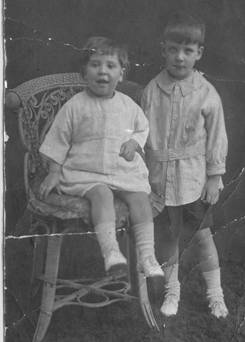 |
|
|
Frank and his sister when their father
worked in Batley as a loom turner. |
When their father worked could
no longer work as a loom tuner. |
|
|
|
Frank Senior, aged 13, by the Batley relative's car. |
My father liked living in Saltaire but was disappointed that he couldn’t follow his trade. As a general labourer his work was less stable and my mother had to work as a weaver to help with the family income.
During the general depression and periods of labour strike actions of the 1920’s, my dad was out of work for 4 years. In the early 1930’s things were very bad and whilst my dad did receive some small welfare benefits (known as transitional benefits) and we rented the house from Salts at 4 shillings a week, we often couldn’t afford this amount.
As soon as I was 12 years of age I got applied for and got a licence to work from the Shipley Education Committee and I started delivering morning and evening newspapers which took me about 6 hours a day but each round was worth 6 pence and it helped the family during a depressing time. I found then that the cinema was a ‘great escape’ for me in any spare time.
In 1931, luxury cinemas began to be built and Bradford had one of the finest, it was called ‘The New Victoria’ – later to become the Gaumont and Saltaire also had a new Gaumont. You could go to either before 6pm and get in for 6 pence and then see a double feature, a cartoon, the news and also have the Wurlitzer playing. You went into another world with thick carpets and comfortable seats and this experience was my main interest in life.
My family lived at 18 Edward Street in the village. From 12 years of age I was earning 8 shillings and sixpence and this was given to my mother. Prior to this money earned from the newspaper rounds, I used to go to the shops for older people and run Saturday errands for 2 shillings – I would walk to Bradford and back to get full value for my money and use all that I had to buy toys.
I was a member of the Saltaire Congregational Church, being baptised there, and for 15 or 16 years I went to Sunday school on Victoria Road, I enjoyed the bible classes. Apart from my work at this age, the cinema, helping neighbours and Sunday school, I was a bit of a lone wolf. Unfortunately I spent most of my school holidays with my Grandma in Batley so wasn’t considered to be a regular attendee at Sunday school.
My mother read a lot of light novels and weekly stories. I was an avid reader but lost my local library when quite young. I wasn’t interested in comics or fiction. I liked biographies from my early teens.
My parents were Labour Party supporters and I always was until 7 or 8 Years ago. Despite this I revered Winston Churchill and later, when I was in the forces, I listened to him on the radio. He was an inspiring leader and I feel that in the post war years, no leader has been inspirational. I like honest, free speaking and I have never voted Conservative. Nevertheless, I have also never liked the extreme left wing or the involvement of Trade Unions in politics.
From 1937, the Nazi Party became prominent in Germany and I heard Hitler whipping people up on my radio. I used to think ‘what are we going to do to counter this hysteria’. I didn’t want to go to war after hearing from my parents about the horrors of the First World War. It was a frightening thought but I became interested in politics and world affairs.
At that time we had people like Chamberlain waving bits of paper saying ‘Peace in our Time’ – I like to think that he won us 12 months in which to prepare our forces.
My father wasn’t a drinker but he liked nothing better that to be a member of the working men’s club and to have his membership card. He could go anywhere in the country and find cheap entertainment and take his wife and children. The only times I went to a public house were to take ‘the empties’ back for some pennies.
I never felt unequal to anyone in the village or that I couldn’t make use of the whole village. It was much later that I realised that the village had operated some class distinction in the past (with larger houses for managers). In my time this wasn’t obvious. The village had been in business since 1871 but there was no class distinction in my time – I just assumed bigger houses were for larger families.
I went to school at 5 years of age in 1924 and stayed there until 1929. I was at the Albert Road School for Primary Education and at the age of 11 years I moved to the Central School down Saltaire Road. In about 1932, the Shipley Education Committee decided to make this a selective school for ‘higher stream’ pupils that required an entrance exam. I missed the qualifying exam for this because I was ill when the exam took place so I wasn’t able to go and had to stay in a secondary form of education.
I was very disappointed that my father and mother didn’t argue my case though my dad couldn’t afford it any way – he needed me at work. I felt that I had the potential but I didn’t feel deprived at that point.
In the 1930’s I was lucky enough to get an apprenticeship – in those days there wasn’t any support from agencies to help you get the right kind of work. My mum didn’t want me to work with machinery because I was small and not very strong.
My mum took me down to the mill (Salts) for a sedentary job and I was given a job in the basement, packing. It was a nice, clean and warm place and I enjoyed it. I finished my newspaper rounds on a Saturday night and on that Sunday (1933) there was a heavy snowfall and it was very cold. I much appreciated the new packing work in the Mill basement.
When I had been in the packing area for 2 months I heard that there was a job going in the Gatehouse of the mill and that this was a job that might lead to an apprenticeship in the mill – offering more for the future.
I applied for the job in the Gatehouse and got it. It involved being a general ‘dogsbody’ – keeping the place clean and tidy, sweeping and cleaning the brasses. In those days, the Labour Exchange used to send unemployed people to the big mills to seek work and, as proof that they had actually been, they were given a green card that had to be signed by someone in the company saying that this person is not suitable for work here or otherwise. It was my job to find the appropriate manager to do the signing. This took me all over the mill and it could take me an hour to find the elusive manager. At that time, unemployed people were only allowed to refuse two jobs offers.
The Firm (Salts) had 4,000 staff at that time because it was a ‘Vertical Mill’ performing every process it took from receiving the raw Australian wool to a length of men’s suiting cloth leaving the mill. In the immediate pre-war years we drew a lot of the labour force from the South Yorkshire coal fields – both men and women and often people had had no textile work experience – they were trained on the job.
In May 1933, I started in the Gatehouse and worked there for two years. The Firm considered that I should be looking for an apprenticeship after two years and it was ‘make your mind up time’.
My father, a loom tuner and my mother, a weaver, decided I should be apprenticed to weaving over-looking. It didn’t appeal to me in the slightest but reluctantly I agreed. The chief accountant came round and said ‘you have exceeded your time here (the Gatehouse) – what are you going to do?’I told him that my mother and father had arranged for me to be apprenticed to a weaving over-looker but said I was reluctant to do this.
He told me that there was a vacancy in the Enquiry Office – more similar to what I had been doing – and that from there I might get promotion to an office upstairs. So I simply swapped one errand type job for another but it was in a better order to try for promotion. The tasks here were similar, if any commercial traveller came round I took them in and then had to find the person they had come to see. I did this for 2 months and when a vacancy occurred in the general office I applied for this. Of course I was at the bottom of the pay scale and this helped me get this job.
My new job was called ‘The Bradford Messenger Job’ where, to save on postage for delivering invoices, I was sent to Bradford by train where I then spent the day delivering invoices by foot. This lasted until about the September of that year (1935). When I came back from Bradford one Saturday morning, the Sergeant Commissioner said ‘you are starting a new job on Sunday – they are wanting someone to learn textile designing and because of your family’s textile background they have chosen you over and above those ready for promotion’.
As you can imagine, this annoyed some people but I could only take the chance that this offered me. I was in this job for 5 years and I took the Textile Institute’s Ordinary National Course, studying for 5 nights a week and Saturday mornings for four years. The course embraced all the aspects of being a textile designer – textile machinery, textile calculations, textile mechanics, textile weaving, design and colours. I sat the National Ordinary Certificate in June 1939. (as it turned out, that was the last I had to do with textiles until 1946).
Textile design was a very important job and prior to 1920, in order to become articled you had to pay to train. I learnt with all the professional designers. Going in as an apprentice I had to weigh and measure lengths of cloth and then submit them to the chief salesman for dyeing and finishing instructions. Then I had to process them through dyeing and finishing.
That was one of the tasks before you started any learning. They were routine jobs but once you had finished those for the day you could go and sit with an experienced designer to learn all about standard weaves and how to create weaves in relation to yarns and about what kind of cloth you were going to make. I was earning 18 shillings and 3 pence a week.
This went on for about 2 years and my father kept asking me ‘when are you going to get a rise’. I said that it was up to the manager to give me a rise and I didn’t want to ask. Of course, he gave me an ultimatum and said ‘if you don’t ask I will do it for you’. The chief accountant was a small chap, very dictatorial and not easy to get on with and his office was in the main accounting room.
I went down there to see him very hesitatingly, knocked on his door and told him that I hadn’t had a rise for 2 years. Without any further conversation, he got hold of my arm and took me out into the main area stating very loudly ‘what makes you think you are worth any more?’ it was very embarrassing so I told him that my father thought that I was at least entitled to a rise or an explanation and I got a 5 shillings rise.
This was 1937, and then another year went by without a merit award. In about 1938 a man called Sydney Jackson was employed in the sales costing office and he was contemplating moving on. Sydney’s superior was concerned to find a suitable replacement. It had to be someone with a design background because if you are costing out cloth you have to know what you are doing.
Sydney had the bright idea that because of my wage dissatisfaction I might be interested, so he came to see me one morning and said ‘how would you like to come and do my job? – I am leaving and my boss needs a replacement’. By that time I was beginning to feel that I needed more money. His boss, Mr. Crabtree, asked me how much I was earning (23 shillings a week) and said ‘well we could double that’. I didn’t need any more encouragement but as a young man, somewhat naïve, I asked him to make it all right with my then boss – who was probably glad to see the back of someone always wanting rises.
So because of that I went into costing and it was a job I was to continue for the rest of my years at Salts Mill – eventually becoming the head of the Costing Department. The work involved costing out the price of a yard (later a metre) of a piece of cloth. We used to make 700 to 800 different types of cloth each year, mostly worsted. On the ‘ladies’ dress side we used a lot of woollen yarn for effect and also some silk yarns. Some yarns we picked up from a well known Bradford Agent – yarns that contained all sorts of matter such as rabbit or skunk hair – and as fashions changed, the yarns had to change.
We made a range of cloth as well as worsted cloth and you had to cost out how much of what yarn you were going to use in the cloth, how the cloth would be set and constructed, how many yards needed from the loom, the dyeing and finishing process times and costs and then work out what the yield would be from those. My four years learning about cloth construction and design were a good fit for this job. I had realised when apprenticed as a designer that I didn’t have creative potential, I could copy the designs of others but wasn’t creative enough so I had been right to change tack.
It was a very fluctuating trade (Textiles) in respect of changing fashions. Fashion remained more consistent for men with construction remaining very similar but there was a need for a good colour sense using yarns already dyed. There was less to think about as most of the thought was about colour or striping effects, subtle hues and the type of finish. On the other side, women’s fashions changed a great deal and it was the ‘weave’ that gave the effect to the cloth and different yarns created different effects.
It was my job, if a salesman wanted a selling price for one of our quality or new cloths, to go to design and extract the making particulars - the reed width, the picks, the weft count, the warp and the yarn or yarns used – and then find a spinner who could supply the yarn at a competitive price. Then I had to go to the accounts department to assess the overhead costs. In those days we based overhead costs on the most expensive part of the production line of the manufacture – which was the weaver’s wage. This formed the rate worked out by the accountants that had to be recovered. Added to these costs were the costs of storage, making up and carriage – you had to calculate all of these into the price.
Due to the growth of Nazi power in Germany and the increasing certainty of war; the British Government decided to introduce conscription in peace time. They decided that men aged between 20 and 21 years would be called up to do six months training and would be called ‘Militia Men’. Men of this age had to register all over the country at local Labour Exchanges on Saturday 3 June 1939.
I duly registered on that day and I expressed a desire to join the Royal Air Force. Most of my comrades chose the army and a few chose the Royal Navy. These men were called up pretty quickly for those branches of the armed forces. Because I had chosen the RAF, I never heard a word from the authorities until November 1939. I was called for a medical and passed for the RAF. I took the liberty of asking the Squadron Leader – “why the delay”?
The answer was that we were still building aerodromes. The Squadron Leader suggested that I return to my employment at Salts Mill and said that I would hear from the Squadron in due course. I had already met the woman who was to become my wife but did not know this at the time. I first met Ilma when she was 15 years of age and she joined the Company – she had started work at the Mill as a temporary worker in Burling and Mending before she got an office job. When I went to work for Mr. Crabtree she was there and although I was very attracted to her we did not begin a courtship.
It was a further 6 months before I had to report for duty on the 23 May 1940. I went to Padgate in Chesire for Basic Training. Unknown to me, the French Government was seeking peace with Germany and its army had capitulated and the British Army were in retreat.
|
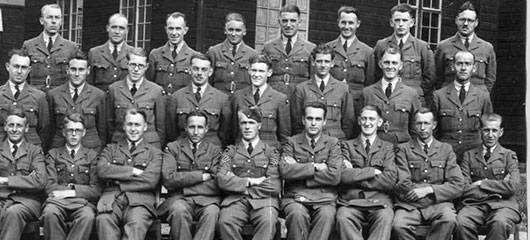 |
|
Frank in training at RAF Cranwell, June 1940, middle row, third from the right.
|
|
|
|
Frank met his cousin unexpectedly in Suez 1941. |
After basic training (and when the war against Germany had been declared) I went on to serve for 4 years and 2 months of continuous service with the RAF in Egypt. I was posted to a new unit – a movement control unit – and served out the whole of the war with this unit. I left home on Saturday 9 November 1940 and didn’t return until Friday 12 January 1945. I served the remainder of my war service at an RAF station in East Yorkshire, finally being demobbed on 31 March 1946.
My unit dealt with the receipt of personnel from the United Kingdom, pilots and their crew, shipping them off to their various units for action. Some personnel arrived at my unit from Africa. This movement of pilots and crew was only part of my job. My unit worked in conjunction with the Royal Engineers who served in Egypt as docks operating companies. When I worked on the docks I had to be on the quayside when ships came in, check the equipment and get this transported into the desert.
I was a non-combatant throughout the war but the conditions were hot and harsh and diseases were rife. Many personnel were lost through smallpox, typhoid and similar diseases – one member of staff contracted Bubonic Plague. I became ill in the desert and I had to be moved to the southern end of the Suez Canal where conditions were a little better.
On demobilisation, the government guaranteed service men and women at least 6 months employment and I returned to Salts Mill. Salts were good to their word and retained returning service personnel in their employment. Mr. Crabtree was still head of the costing department and I settled back into this work.
Throughout the war years Ilma had written to me, despite the fact that she had become engaged to a soldier from Derbyshire who was stationed temporarily in Shipley. I had also had a romance with someone. My romance started in 1940, after leaving Saltaire, when I had joined a hiking group and met a young woman and struck up a romance. I became engaged to her in the summer of 1941 but it had been too rapid a romance with no depth to the relationship and it ended when she got fed up of waiting for me to return.
Ilma had also joined the forces, being conscripted in 1942 and becoming a staff sergeant in the Army Service Corps, based in Newcastle. Her letters had been constant throughout the war years and towards the end of the war she wrote to ask me to let her know when I got home. She said that she would get a weekend pass and that we could celebrate my return.
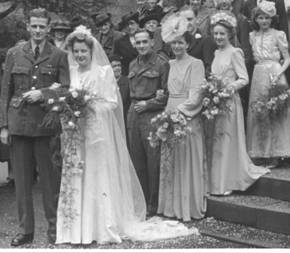 I let her know the date of my return and we met in Leeds Station on the Friday night and were together the whole week-end until I saw her back to the train for Newcastle on the Sunday evening. I wrote to her on the Monday morning, thanking her for a lovely week-end and asked her if I might have misread the signals from her over the week-end – had I imagined these. She replied straight away and said ‘my answer would definitely not be no’. We were married in the June of that year. [Picture: Frank and Ilma Senior on their wedding day, 6 June 1945.] I let her know the date of my return and we met in Leeds Station on the Friday night and were together the whole week-end until I saw her back to the train for Newcastle on the Sunday evening. I wrote to her on the Monday morning, thanking her for a lovely week-end and asked her if I might have misread the signals from her over the week-end – had I imagined these. She replied straight away and said ‘my answer would definitely not be no’. We were married in the June of that year. [Picture: Frank and Ilma Senior on their wedding day, 6 June 1945.]
Meanwhile, back at work, I learnt that during the war Salts Mill had worked on Government contracts for cloth and had ceased making any cloth for public use. My boss, Mr. Crabtree, had been given the role of communications and had to oversee cables and letters from all over the world. Getting back to the work of making cloth for the public was very gradual but the mill slowly returned to normal over the next two years and the return to making cloth for export took even longer – to get permission for this we had to have an order from someone and then seek permission.
My boss, Mr. Crabtree, maintained both the communication role he had acquired during the war and the work of the costing department for some time after my return. It was difficult to do both and I used to ask him why he didn’t stop the communications work but he felt he could not do so and I also became involved in that work.
The telephone would ring and it would be up to 5 cables and, as an example, one could be from Geelong in Australia and have 35 words in code. We had to take down all the words in longhand and then repeat them to check accuracy in recording the 5 letter code. The code was designed for the wool department and they were the only ones with the information to decipher the code.
My team had to type up 12 copies of the message in code and take these around to the various units. The wool department would then bring back their response and we then had to send their coded responses back by cable. This work typically took up to 2 hours each morning in the wool sales season before costing work could begin and we eventually took on a young female worker to help with the communications work.
The Managing Director at this time was Mr. R.W. Guild and he had appointed his son, Mr. Park Guild as Deputy Managing Director of Salts. Mr. R.W. Guild had been brought into the company by Mr. E. H. Gates – he had been Mr. Gates’ agent in Glasgow prior to this and always took his holidays in his native Scotland.
During the war, his son, Mr. Park Guild, was part of the observation corps, spotting enemy aircraft, but the authorities did call him up after a time, to serve in Burma. He had begun the process of serving in the forces but his father argued strongly for his release due to his important role in this large textile company employed on government contracts.
At the time, R.W. Guild had a very influential Chairman who was a Conservative Member of Parliament, Sir Frank Sanderson and the argument prevailed, so, although Park Guild flew to Burma, he had just disembarked when he was allowed to return home.
When my wife Ilma was called up the company tried to get her out of the draft as she was very skilled and much needed but the effort in her case failed.
Salts had always been a ‘vertical mill’ and trade did fluctuate and was always difficult. R.W. was against using synthetic fibres which were then beginning to be blended with wool. ICI had invented Terylene and R.W. took months in considering whether to use this. Also, all the mill machinery had always been built locally, at Hattersley’s Keighley or Dobcross near Huddersfield. These machines allowed 1 weaver to cover a multi-box and a single box loom each. Sulzer had brought out new automated looms, costing £5,000 per machine and one weaver could then cover many more looms. Illingworth Morris invested heavily in these machines and weaving changed from then on.
Prior to this point, I had lost my manager Mr. Geoffrey Crabtree who had been ill for a year (during 1957) prior to his death, a year when I had had to manage the department. It had been a difficult year for the business because the wool markets in Australia and New Zealand went haywire with prices fluctuating rapidly and prices having to be re-calculated many times. Mr. Crabtree had not had a correct diagnosis for most of the time he was ill but on the Friday night that he left work for the last time I could see how ill he was and it was an inoperable brain tumour that killed him shortly afterwards. I was asked to take on the role of Head of the Costing Department - Mr. R. W. Guild was still managing director at the time – and I agreed to take this on.
The costing department were still undertaking telecommunications work (which continued until 1971). The codes were designed to prevent international competitors knowing what we were paying for wool. When Mr. Crabtree died in 1957 and I was appointed as the Head of Department for costing, I suggested that we rent a telex machine from the General Post Office (GPO) and this was agreed. I was sent to the GPO in Leeds to see a demonstration and arrange for the machine to be fitted.
By this time I had 3 female staff, one of whom volunteered to operate the telex and she did this well, keeping a record of all incoming and outgoing calls and enabling me to get on with costing work. But things were about to change in the costing work also. Illingworth Morris, from gaining control of the Company in 1958, insisted that the firm brought costing (or pricing) cloth into a modern accountancy basis.
The method of costing in use, from my starting work in costing, was an Ernest H. Gates system which had been adapted to take on a John ‘Wrights’ and a ‘Salts’ (Saltaire) System. For some cloths we would use a specific weaving company – for example men’s suiting was woven at Salts Mill and ladies cloth was woven by John Wrights or Ernest H. Gates at Crossroads, Keighley.
Sometimes the textile trade unions would say ‘the weavers aren’t earning enough from this work’, (it was piece work) but if the cloth was of the type that was slower to weave, this had to be recompensed in some way. It was a complex job!
Having decided which companies weaving costs we were going to use, the next question was how do we get a standard for other overheads (dyeing, finishing, warehousing and so on). Every year the accounts department decided on the overheads required which was decided at 4 times the weavers’ wage.
Whilst in the RAF, the warrant officer lost the man who had been responsible for recoding modifications to aircraft and other vital machinery and the Squadron Leader asked me if I would be prepared to undergo a qualification and take on this work. I was keen to do this but unfortunately fell ill and the medics reported that I must get out of the desert, so I was transferred to dock work. I did feel that my aptitude for this kind of work helped me when I returned to work at Salts.
From this work on costing cloth and calculating changes to cost from modifications, I could give a price to the sales people. They would often argue the price but it was not based on their view. For years we had some semi-automatic looms in New Mill at Salts which were less expensive and this point was sometimes used in the sales people’s argument but R.W. Guild always refuted this argument knowing the differentials according to the cloth and weavers chosen in terms of quality.
When the cloth was going out to Burtons (one of our largest customers) it was essential to get the price right because at the time other countries such as China and India were ‘buying our brains’ and creating their own textile industries. I remember one occasion very well when R.W. asked his son Park ‘how many thousand yards do they want’ and Park’s reply was ‘if we price anything above 20 shillings a yard we won’t get their order’, at this R.W. did compromise.
Unfortunately, this made our work look foolish and we were then asked what we could eliminate in our overheads and Illingworth Morris introduced ‘budgetary control costing’ and did away with our ‘plus four formula’. For the new system, there had to be more staff and all the separate processes were given their specific budgetary controls – for example spinning cost controls and manufacturing cost controls – and each cost control unit had to provide a monthly profit statement from their department. If the cloth was in a ‘grey state’ i.e. not finished, a notional finishing cost was added on. R. W. himself had to keep a record of all wool bought, what was in stock and what current prices were and provide details of what then was the average raw material price.
Overall, the new system brought in 20 new staff. For example stock taking had occurred once each year but Illingworth Morris wanted a stock take each month. In 1971 the managing director of Salts came to see me and said, ‘Frank, I want you to move to the bottom of the office and get rid of the female staff’. I replied by asking who would do the telecommunications work and at this he was silent. We did manage to keep the telex operator but she was moved shortly after this to the accounts department.
The company Pepper Lee had been acquired by Salts (Saltaire) Ltd. prior to Illingworth Morris gaining control and their processes had been brought into New Mill. When Mr. Park Guild resigned in 1962, the board appointed Mr. Geoffrey Pepper as managing director at Salts and he retained that position until 1971, when he died.
His right hand man was called Mr. Viney and in the five years from 1970 to 1975 the Salts (Saltaire) company died. Illingworth Morris got rid of Mr. Viney in 1975 (he just disappeared). The only communication with staff was a notice on the notice board stating that ‘Mr. Viney, lately MD of this company, has now left the services of the company’. After I retired Illingworth Morris brought in two new people for the board.
On a personal note, after marrying Ilma and the birth of our son, Geoffrey, Ilma stayed at home to care for him and she didn’t return to work until 1962. A friend of hers, who wanted part-time work, was nervous about trying for a job at Salts and she asked Ilma to apply with her, saying she only felt able to go if Ilma did also. Our son was 16 years of age by this time and Ilma needed to have some personal stimulation so she agreed to go and was taken on in stock control.
In 1965 however, Ilma’s mother had a slight stroke whilst we were on holiday and we came home and brought her mother to our house in order to care for her. Ilma cared for her from the summer of 1965 until the December of that year when she died. Ilma then went back to work at Salts with the cost control teams.
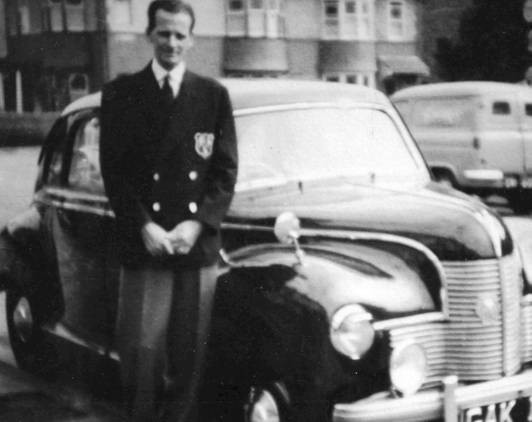 |
|
Frank with his first car – a Jowett Javelin – 1960. |
|
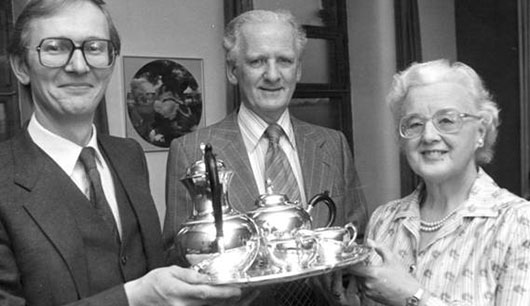 |
|
Frank and Ilma being presented with a silver tea set, by Edward Stanners,
on his retirement from Salts in 1983. |
PostScript:
Frank retired in 1983, a few years before the mill ceased operating as a textile manufacturing concern in 1986 – selling its order books to Drummonds, Bradford.
Written by Maggie Smith, December 2013, from conversations with Frank Senior.
Grateful thanks from the Saltaire Village Website team for sharing this article. Thank you Frank and Maggie.
|

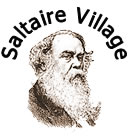
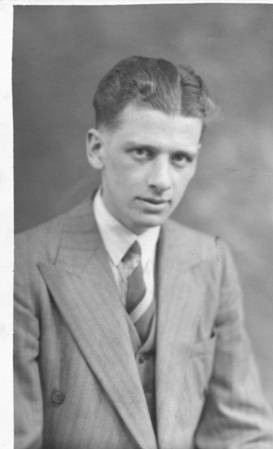

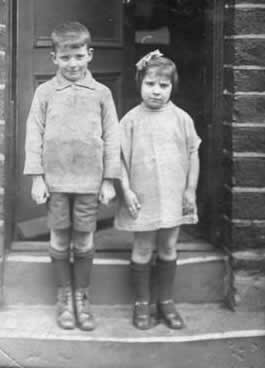
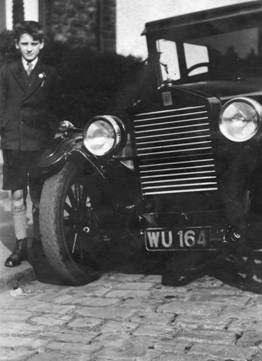

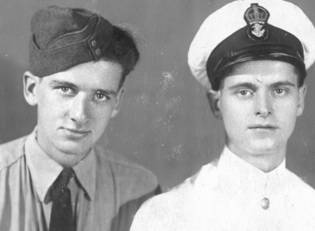
 I let her know the date of my return and we met in Leeds Station on the Friday night and were together the whole week-end until I saw her back to the train for Newcastle on the Sunday evening. I wrote to her on the Monday morning, thanking her for a lovely week-end and asked her if I might have misread the signals from her over the week-end – had I imagined these. She replied straight away and said ‘my answer would definitely not be no’. We were married in the June of that year. [Picture: Frank and Ilma Senior on their wedding day, 6 June 1945.]
I let her know the date of my return and we met in Leeds Station on the Friday night and were together the whole week-end until I saw her back to the train for Newcastle on the Sunday evening. I wrote to her on the Monday morning, thanking her for a lovely week-end and asked her if I might have misread the signals from her over the week-end – had I imagined these. She replied straight away and said ‘my answer would definitely not be no’. We were married in the June of that year. [Picture: Frank and Ilma Senior on their wedding day, 6 June 1945.] 
